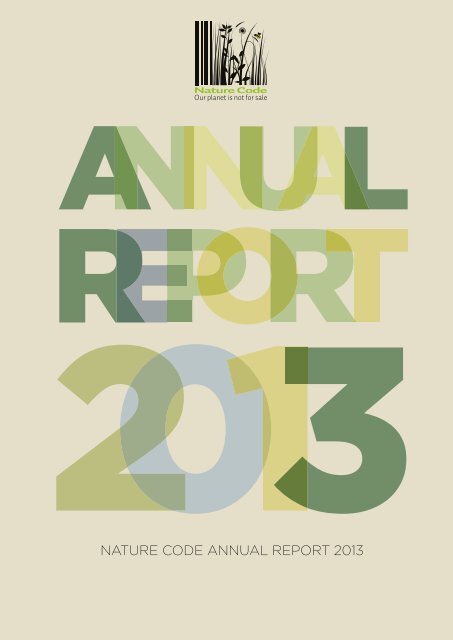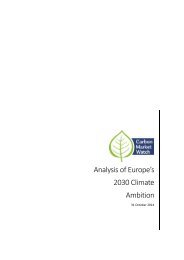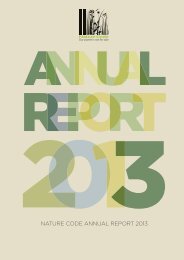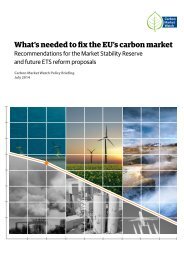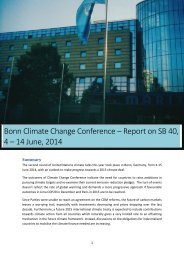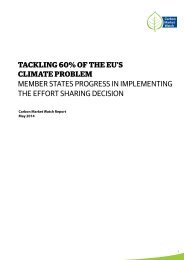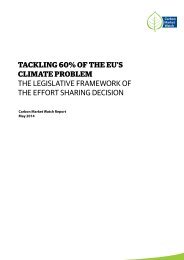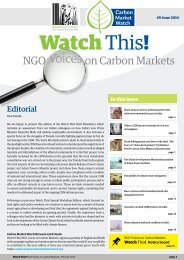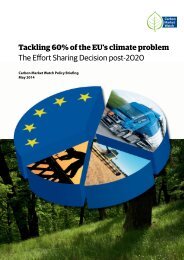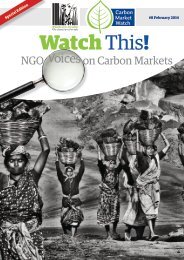NATURE CODE ANNUAL REPORT 2013
Create successful ePaper yourself
Turn your PDF publications into a flip-book with our unique Google optimized e-Paper software.
<strong>NATURE</strong> <strong>CODE</strong> <strong>ANNUAL</strong> <strong>REPORT</strong> <strong>2013</strong>
OUR MISSION<br />
Nature Code Annual Report <strong>2013</strong><br />
Date of publication: November <strong>2013</strong><br />
© Nature Code – Centre of Development & Environment <strong>2013</strong><br />
No part of this publication may be reproduced in any form or by any<br />
means without permission in writing from Nature Code – Centre of<br />
Development & Environment.<br />
Nature Code – Centre of Development & Environment<br />
Rue d’Albanie 117<br />
B-1060 Brussels, Belgium<br />
Website: www.naturecode.org<br />
Email: info@naturecode.org<br />
Twitter: @nature_code<br />
Graphic design: Pietro Bruni<br />
Nature Code’s mission is to ensure<br />
that the protection and welfare of<br />
all living beings and ecosystems lie<br />
at the heart of environmental policy<br />
making.<br />
We champion policy solutions that<br />
promote environmental integrity,<br />
transparency, good governance and<br />
sustainable development.<br />
We support civil society groups<br />
around the world in building networks,<br />
gaining access to information<br />
and holding the powerful to account.<br />
We dialogue with decision makers to<br />
find solutions at national, regional<br />
and international levels.<br />
2
FOREWORD<br />
<strong>2013</strong> was another busy and eventful year for Nature Code and its associated project Carbon Market<br />
Watch. With new developments in international carbon markets continuing to flow thick and fast,<br />
we paused only briefly to celebrate our official launch in July before getting our noses back to the<br />
grindstone!<br />
Despite plummeting carbon prices, plans for emissions trading and crediting schemes continued<br />
to gather apace. The world’s most developed carbon market, the EU Emissions Trading Scheme<br />
(EU ETS), still bedeviled by massive oversupply of allowances, was the focus of attention throughout<br />
the year as legislators debated ways of cutting the surplus, both through the temporary fix<br />
of “backloading” and long-term structural measures. Throughout the year, European policymakers<br />
debated plans to postpone the auctioning of 900 million EU ETS allowances until 2019-2020 to<br />
allow demand to pick up in the short-term but, sadly, this temporary fix will do nothing to resolve<br />
the huge structural flaws in the overarching framework. In international talks, the EU also bowed to<br />
pressure from the aviation lobby to give airlines an easy ride by upholding an exemption from the<br />
EU ETS for intercontinental air travel.<br />
But there was good news as well. In <strong>2013</strong>, investor interest in funding coal power through the UN<br />
Clean Development Mechanism (CDM) continued to shrivel. Our international network expanded<br />
to welcome new members from Papua New Guinea and Taiwan, bringing our global presence to 70<br />
countries.<br />
2015 is the date on everyone’s minds now, as we look ahead to the conclusion of a global deal on a<br />
new climate regime post-2020. Will the new agreement mean business-as-usual or herald a novel<br />
and exciting chapter in the international community’s attempts to rein in dangerous man-made<br />
climate change? Will countries agree to take on binding and genuinely ambitious emissions reduction<br />
targets or stick with the increasingly unsafe status quo? These are crucial questions with a<br />
significant bearing on the future of global carbon markets.<br />
As this report highlights, ambitious emissions reduction targets are a sine qua non condition for<br />
access to markets. As things currently stand, the global carbon market – such that it is - is an empty<br />
shell. Supply has far outpaced demand at both the regional and international level. It’s a moot point<br />
whether politicians will be able to rise to the challenge of fixing the mammoth flaws in the system<br />
so that the carbon market is able to achieve its core objective, which is to provide a tool for making<br />
cost-effective reductions in CO 2<br />
emissions on a planetary scale. The very real concerns that civil<br />
society organisations around the world continue to raise, both regarding environmental and social<br />
integrity as well as overall sustainable development are simply going unaddressed.<br />
With many countries unwavering in their determination to develop carbon markets, it is imperative<br />
that climate negotiators get it right.<br />
CONTENT<br />
Foreword 2<br />
Removing international offsets from the EU’s climate legislation 3<br />
European Emissions Trading 3<br />
Bumpy take-off for EU aviation emissions regulation 5<br />
The global carbon market 6<br />
Rocky times for the CDM 7<br />
A future for Joint Implementation? 8<br />
China’s carbon market 9<br />
Fighting climate finance for coal power 10<br />
Local realities and capacity building 11<br />
Carbon Market Watch Network 12<br />
Communications 13<br />
Media exposure 15<br />
Funders + Finances 17<br />
Overview of staff members 20<br />
Overview of steering committee members 21<br />
Natasha Hurley<br />
Vice - Chair of Nature Code<br />
4<br />
5
“It’s a travesty that countries<br />
spend billions on international<br />
offset credits instead of investing<br />
in energy efficiency measures and<br />
renewable energies on the home<br />
front.”<br />
Carbon Market Watch RTCC, October <strong>2013</strong>.<br />
Removing international offsets<br />
from the EU’s climate legislation<br />
Carbon Market Watch has taken centre stage in the successful fight for policy changes at EU level against allowing more international<br />
offsets in EU climate legislation post-2020 . Through our targeted outreach and strong ties with affected communities on the ground<br />
the case for limiting the use of international offsets in the EU grew stronger and stronger. Carbon Market Watch has used its expertise<br />
and findings on the ground to lobby the EU institutions and offset buyers regarding the adverse social and environmental impacts that<br />
offset projects can have for local communities and indigenous peoples. Furthermore, by underlining the lack of political willingness<br />
to reform rules at UN level, Carbon Market Watch has successfully pressured the EU to take a step forward and reconsider offset use<br />
pre- 2020 and banning altogether the use of international offsets post- 2020.<br />
The hard won fight against international offsets in EU climate legislation is not over yet. Depending on what EU Member States decide,<br />
there is still the possibility that some Member States would like to preserve the access to international offsets post-2020. While the EU<br />
carbon market is forecast to be heavily oversupplied and continue to remain so post-2020, access to offsets is still granted up to 2020.<br />
Working to ensure that international offsets no longer have a role to play in EU’s 2030 climate legislation, Carbon Market Watch will<br />
continue to scrutinize offset projects and advocate for strict quality and quantity restrictions in the EU.<br />
European Parliament Event, 6 November <strong>2013</strong><br />
EU climate policy sign-on letter; press release; policy brief<br />
DID YOU KNOW ?<br />
Studies estimate that only 40% of all offset credits sold actually represent real emissions reductions. This is a serious<br />
problem and implies that the use of international offsets undermined the EU’s climate goal by 840 million tonnes<br />
under the first Kyoto commitment period. Eliminating access to international credits after 2020 will help ensure a<br />
stronger focus on domestic abatement and spur investment in low-carbon technologies in Europe.<br />
SOURCE: http://www.cdmpolicydialogue.org/<br />
CAMPAIGN PAGE: http://carbonmarketwatch.org/eu-2030-climate-and-energy/<br />
7
European Emissions Trading<br />
The European Union Emissions Trading Scheme (EU ETS) is the largest cap-and-trade scheme in the world and Europe’s flagship instrument<br />
to cut greenhouse gases from industrial polluters. The EU ETS regulates about half of the EU’s CO 2<br />
emissions. A deep economic recession<br />
and the heavy inflow of cheap international offsets have negatively impacted the functioning of the EU ETS and brought down the<br />
price of carbon allowances to record low levels of around 3 Euros in March <strong>2013</strong>.<br />
By underlining the dangerous consequences that the large inflow of international offsets entering the EU ETS has had on the functioning of<br />
the market, Carbon Market Watch has been a prominent leader amongst NGOs asking for a deep overhaul of the EU ETS. The debate around<br />
structural reform was discussed throughout <strong>2013</strong> with the release of proposals expected in early 2014.<br />
Following submission to the EC Consultation green paper on options for structural reform to the EU ETS and the 2030 climate and energy<br />
package, Carbon Market Watch has been in close cooperation with MEPs, stakeholders and NGOs drawing attention to the dangers a low<br />
carbon price and dysfunctional ETS has on EU’s long term international climate commitments as well as the EU’s plans for decarbonisation<br />
its economy by 2050.<br />
We have ensured that our messages calling for major policy changes in the EU ETS reach all stakeholders involved in EU climate policy. The<br />
debate aimed at reforming Europe’s compliance market is expected to resume in EU Parliament next year.<br />
Backload to the future…<br />
“Exceptional macro-economic<br />
developments and the fact that<br />
emissions have been substantially<br />
lower than the cap rendered the<br />
quantity limit of international<br />
credits in the period 2008 to 2020<br />
too generous (...) The use of UN<br />
offsets will represent nearly twothirds<br />
of the market’s surplus by<br />
2020 “<br />
Carbon Market Watch- Bloomberg, March <strong>2013</strong>.<br />
Back-loading would withhold 900 million allowances from auctioning progressively. They would then be added back<br />
to the market through 2020 to ensure that oversupply levels don’t aggressively bring down the price of allowances. But<br />
a structural reform to the ETS is needed to ensure that the price of carbon allowances is adequate to attract renewable<br />
energy shift amongst largest polluters and also ensure that the EU respects its international commitment of limiting<br />
global temperature rise of 2 degrees Celsius by 2050.<br />
EU Policy Briefings, November <strong>2013</strong><br />
DID YOU KNOW ?<br />
By 2020, the EU emissions trading scheme (EU ETS) will be oversupplied by around 2.6 billion allowances while, at<br />
the same time, cheap and low quality 1.6 billion international offsets have and will still continue to flood the market<br />
by 2020 (approximately 550 million offsets can still be used in the EU ETS until 2020). International offsets can also<br />
be used in the ESD sectors (transport, buildings, agriculture) where, most worryingly, quality standards applicable<br />
under the ETS are not mandatory for ESD sectors.<br />
SOURCE: http://www.bloomberg.com/news/<strong>2013</strong>-03-04/environmental-lobby-urges-eu-to-ban-un-carbon-offsets-after-2020.html<br />
CAMPAIGN PAGE: http://carbonmarketwatch.org/category/eu-climate-policy/eu-ets/<br />
9
Bumpy take-off for EU<br />
aviation emissions regulation<br />
In 1997, the Kyoto Protocol required states to find solutions through the UN aviation body, the International Civil Aviation Organization<br />
(ICAO). However, ICAO failed to move for years to agree binding mitigation measures and as a response the EU decided to include all emissions<br />
from flights to and from EU airports in the EU ETS starting in 2012. This unilateral decision has been very controversial, triggering<br />
fierce international opposition and threats of trade war by many countries including the US, Russia, China and India. As a sign of compromise<br />
and in order to give ICAO enough time to negotiate a global aviation agreement, the EU decided to exclude international flights from<br />
its ETS for the 2012 period. This was agreed in September 2012 but as the derogation was set to expire in one year, the debate resumed once<br />
again in <strong>2013</strong>. Recently, the EU backed down again, extending once more the derogation until 2016, hoping that progress will be made at<br />
ICAO’s triennial Assembly in 2016.<br />
Carbon Market Watch has been active in the debate around regulating aviation emissions. Through our research and advocacy efforts, we<br />
supported EU efforts to regulate emissions from international aviation albeit with a maximum degree of environmental integrity. Covering<br />
only partly the emissions from EU airspace was a political compromise at the expense of international pressure. While some MEPs were<br />
highly vocal against extending the derogation, overall support from the EU Parliament was not enough.<br />
Carbon Market Watch has actively lobbied that the EU should not extend its initial 2012 derogation and increase pressure in ICAO for a<br />
global deal with high environmental integrity.<br />
We will continue to stay focused on ICAO negotiations that are meant to steer a global market based mechanisms in 2016.<br />
“Only a cap-and-trade scheme with<br />
a stringent cap and a limit on the<br />
use of offsets will create sufficient<br />
incentives for essential emission<br />
reductions”<br />
Aviation Policy Briefing and UNFCCC side event invitation, June <strong>2013</strong><br />
DID YOU KNOW ?<br />
Greenhouse gas emissions from international aviation make up 5% of global emissions. At the<br />
same time, aviation is the most carbon intensive mode of transport. If aviation emissions would<br />
represent a country, this would be the 7th most polluting country in the world. Future projections<br />
foresee a steep growth of emissions from international aviation.<br />
Carbon Market Watch - Reuters Point Carbon, June <strong>2013</strong>.<br />
CAMPAIGN PAGE: http://carbonmarketwatch.org/category/aviation-shipping/<br />
11
The global carbon market<br />
New national and regional emissions trading schemes and offsetting programmes have been established and are being developed in many<br />
countries, including Japan, California, China, South Korea, Kazakhstan. A crucial question is to what extent such market mechanisms should<br />
follow a common framework of rules under the UNFCCC and play a role in a post-2020 framework.<br />
Parties also decided to establish a New Market Mechanism (NMM). But the political appetite for such a new mechanism is low. Again many<br />
Parties were rightfully concerned that to establish a new market mechanism would preempt the discussion on a new climate deal. So far the<br />
negotiations on both items have not moved forward.<br />
We have spent much time in <strong>2013</strong>, providing evidence to policy makers that they must establish sound rules for accounting and to coordinate<br />
any decisions with the negotiations on the new climate deal before rushing into operationalizing new markets.<br />
In Warsaw we engaged with decision makers and publically campaigned on the Framework for Various Approaches (FVA) negotiations taking<br />
place there to outline our positions in the policy brief (see below) also published in November. Parties remain divided as to how this framework<br />
should look. Carbon Market Watch along with a handful of other NGOs following the technicalities have continued to highlight oversight,<br />
transparency and double counting concerns as the talks roll on to the next round in Lima next year.<br />
Framework of Virtually Anything<br />
Both the NMM and the FVA “must<br />
meet standards that deliver real,<br />
permanent, additional and verified<br />
mitigation outcomes, avoid double<br />
counting of effort, and achieve a<br />
net decrease and/or avoidance of<br />
greenhouse gas emissions”.<br />
Verified Carbon Standard – VCS<br />
Gold Standard<br />
AMBITION FIRST!<br />
Chile Emissions Trading Scheme<br />
Joint Implementation - JI<br />
D ON’T LET L OW-Q UALITY CA RB O N M A R KETS U N D ER MIN E CLIM ATE TA RGETS<br />
Climate Action Reserve Australian Emissions Trading Scheme<br />
S outh Korea Greenhouse Gas E missions Trading Sche m e<br />
Bilateral Offset Credit Mechanism - BOCM<br />
International Emissions Trading - AAU<br />
California Emissions Trading Scheme - CA ETS<br />
European Union Emissions Trading Scheme - EU ETS<br />
New Zealand E missions Trading Scheme<br />
China’s Emission Trading Schemes<br />
Clean Develop ment Mechanism - CD M<br />
Regional Greenhouse Gas Initiative - RGGI<br />
Under the UNFCCC, Parties decided in 2012 to establish an international<br />
framework – called Framework for Various Approaches (FVA) – that would have<br />
rules for such market mechanisms that function outside the Kyoto Protocol.<br />
Parties, such as Australia, Japan, New Zealand and the US, would like to see such<br />
a framework be largely country-driven without much international oversight and<br />
rules. Other Parties such as the members of the Alliance of Small Island States<br />
(AOSIS) have been calling for comprehensive rules and centralised international<br />
oversight.<br />
An FVA may also negatively influence the discussions about a new climate<br />
deal that would start in 2020. One of the main arguments in favour of market<br />
mechanisms has been that they create an incentive for countries to take on<br />
higher targets than they would otherwise. But to date carbon markets have<br />
not incentivised countries to take on adequate commitments. Actually, carbon<br />
markets seem to have done little to incentivise climate action. It is therefore<br />
premature to establish new rules for a market framework before it is clear what<br />
kind of commitments countries are willing to agree to under the new climate<br />
deal.<br />
FVA newsletter article; policy brief, Russian submission, <strong>2013</strong><br />
Submissions on Policy Issues to UNFCCC, Carbon Market Watch Recommendations<br />
for SB-38, May <strong>2013</strong>.<br />
CAMPAIGN PAGE: http://carbonmarketwatch.org/category/new-market-mechanisms/<br />
13
New coal power plants, no matter<br />
how efficient, undermine climate<br />
mitigation goals by locking in millions<br />
of tons of CO 2<br />
emissions over decades<br />
to come.<br />
Recommendations for the CDM Reform: End Climate Finance for Coal Power, November <strong>2013</strong> .<br />
Rocky times for the CDM<br />
The UN’s Clean Development Mechanism is one of the two Kyoto offsetting mechanism. Almost 7,500 CDM projects will have been<br />
registered by the end of <strong>2013</strong> and 1.4 billion offsets issued. However, the CDM is in crisis. Prices have dropped by over 90% in the last<br />
two years and are still less than half a Euro. This is not only because countries have such weak climate targets that there is little demand<br />
for offsets but also because the market has been swamped with low quality offsets. Researchers estimate less than 40% of CDM offsets<br />
represent new emission reductions.<br />
Throughout <strong>2013</strong> we advocated for strengthening CDM rules and provided detailed recommendations to the CDM Executive Board at<br />
the UNFCCC negotiations. This has led to significant progress, with Parties directing the secretariat to draw up sustainability guidelines<br />
for CDM host countries to follow when requested. We also advocated to improve CDM stakeholder consultation rules and enabled local<br />
community representatives to present their experiences first hand to a high level panel at COP19. This was a valuable lesson for both sides<br />
to see how far the debate has actually moved forward.<br />
The CDM would need to be fundamentally reformed, if it is to survive and become a mechanism with integrity that delivers on both its<br />
goals to support sustainable development and deliver genuine emissions reductions. But the political willingness for such reforms is very<br />
low.<br />
Our intense lobbying efforts against coal power projects in the CDM paid dividends, as no new projects were registered in 2012. Further<br />
to this, in <strong>2013</strong> EDF Trading, backed away from one of the 6 already registered CDM projects, the controversial Adani Mundra CDM coal<br />
power project, in India.<br />
Local Concerns<br />
The CDM Executive Board rejected Bonyic Hydroelectric Project in Panama in light of alleged violations of CDM requirements<br />
and human rights standards. The site is part of the traditional territories of the Naso indigenous people.<br />
Numbering around 3,500 people, the Naso face serious threats to their cultural survival due to lack of legal recognition<br />
of their territories and other factors.<br />
Local protests on Barro Blanco Hydro-dam Panama.<br />
DID YOU KNOW ?<br />
Norway was the first country to announce in <strong>2013</strong> to transition away from wind and hydro<br />
projects after research carried out under the CDM Policy Dialogue showed that large-scale<br />
CDM power projects are unlikely to lead to real emission reductions.<br />
CAMPAIGN PAGE: http://carbonmarketwatch.org/issues-in-the-cdm/<br />
15
Countries with a large surplus of<br />
Kyoto allowances (AAUs) – a result<br />
of insufficient ambition – issued<br />
hundreds of millions of JI credits<br />
without any international oversight.<br />
Submissions on Policy Issues to UNFCCC, Herding the Global Carbon Market Cats:<br />
Recommendations for the Negotiations of the FVA, November <strong>2013</strong>.<br />
A future for Joint Implementation?<br />
Joint Implementation (JI) is the other offsetting mechanism under the Kyoto Protocol. Although JI has 15 times fewer registered projects<br />
than the CDM, these 500 projects received over 830 million offsets. This is well over a third of all offsets issued to date. JI has been marred<br />
by a lack of transparency and a glut of credits with very questionable environmental integrity.<br />
Similar to the reform of the CDM, countries were also scheduled in the COP19 negotiations in Warsaw to reform the Joint Implementation<br />
(JI) guidelines but could not agree on the details and the discussion was postponed to SBI40.<br />
Countries also discussed separately whether it should be possible to issue ERUs before countries will get their respective Assigned Amount<br />
Units (AAUs) for the second commitment period of the Kyoto Protocol (CP2). This discussion is significant because each ERU is shadowed<br />
by an AAU but AAUs for CP2 have not yet been issued. The discussion was also postponed to until the June SBI meeting in Bonn.<br />
JI would need to be substantially reformed if it was to have sufficient integrity. Parties to the Kyoto Protocol are discussing revisions of the<br />
rules for JI. But the new draft rules contain only limited improvements that do not sufficiently address the significant flaws of the current<br />
rules. Throughout <strong>2013</strong> we advocated for strengthening JI rules and provided detailed recommendations to the negotiators.<br />
Carbon Market Watch has raise concerns over issues surrounding transparency and oversight in Track 1 projects and the potential difficulties<br />
the negotiation face, dealing with the issue of AAUs. We will continue to urge greater reform in the current mechanisms while advocating<br />
for future agreements to fully take into account the lessons learned from past.<br />
DID YOU KNOW ?<br />
Over 92% (730 million!) JI credits have been issued from projects in Ukraine and Russia. These<br />
are the countries with the largest surplus of Kyoto allowances, which countries can use to<br />
convert to JI offsets. The vast majority of these JI offsets have little if any environmental integrity.<br />
CAMPAIGN PAGE: http://carbonmarketwatch.org/category/additionality-and-baselines/<br />
joint-implementation/<br />
17
China’s carbon market<br />
Between May and August <strong>2013</strong>, we participated in the first China-EU exchange Fellowship on Climate Change and Low-Carbon Urban<br />
Development in China. The fellowship was supported by the German Stiftung Merkator and coordinated by the Chinese Association for<br />
NGOs (CANGO).<br />
Together with the Chinese partner Green Zhejiang, Carbon Market Watch conducted a project that looked specifically at the role of Chinese<br />
NGOs in the development of pilot emissions trading systems currently implemented in 5 cities and 2 provinces in China. The interest in<br />
carbon markets in China proved to be huge. Through media interviews, public presentations and participation in conferences and roundtable<br />
debates in Beijing, Shanghai and Hangzhou we shared our experience and capacities with Chinese NGOs, academia, charities, media, policymakers<br />
and the private sector. Because there is little public scrutiny of China’s carbon market developments, Carbon Market Watch’s work<br />
was highly valued across many sectors. Such interest comes at a time when Chinese society becomes increasingly concerned about the<br />
environmental and climate crises and demands rapid and effective action from their authorities.<br />
Carbon Market Watch’s experience has shown that the environmental and social integrity of carbon markets can be enhanced by setting<br />
up the right governance structure. While legal requirements are desirable, also voluntary guidelines and measures can be helpful in a<br />
future Chinese ETS. Therefore, early and continuous dialogue between Chinese non-profit organisations and policy makers is necessary for<br />
constructive and substantive feedback and input. Increased awareness by all, NGOs, policy makers and market actors will not only improve<br />
the quality of carbon markets but can be applied to a variety of climate mitigation projects across China.<br />
Dragon’s Cap<br />
Throughout <strong>2013</strong> and 2014, China is implementing 7 pilot emissions trading systems (ETS) expected to serve<br />
as a testing ground for a national ETS. The 7 pilots will regulate between 0.8 -1 billion tonnes of CO 2<br />
. If those<br />
trading schemes were to be linked, they would become the second largest cap-and-trade programme aside<br />
from the EU-ETS (which is about twice as big).<br />
“Carbon Market Watch’s experience<br />
has shown that the environmental<br />
and social integrity of carbon<br />
markets can be enhanced by setting<br />
up the right governance structure.”<br />
Diego Martinez Schütt Policy Officer at Carbon Market Watch, <strong>2013</strong>.<br />
DID YOU KNOW ?<br />
Carbon trading is a key element of China’s national plan to reduce greenhouse gas emissions<br />
per unit of GDP by 40-45% in 2020 compared to 2005 levels as pledged in 2009 in Copenhagen<br />
at COP15. The seven ETS pilots will serve to test waters for a future national carbon market<br />
assumed to be included in China’s next Five-Year-Plan (2016-2020). If implemented, it would<br />
become the largest carbon market in the world.<br />
CAMPAIGN PAGE: http://carbonmarketwatch.org/read-our-blog/<br />
19
Fighting climate finance for coal power<br />
Although CDM projects are set to deliver the dual goal of sustainable and a genuinely additional mitigation, they undermine<br />
climate objectives by supporting coal power. These projects, eligible for carbon credits, do not only fail to present real emission<br />
reductions, but have negative environmental and human health impacts and lock in billions of tons of CO 2<br />
emissions<br />
over decades to come instead of investing in renewable energies and a low-carbon development path. Carbon Market Watch<br />
is advocating strongly to stop climate finance for these projects and exclude coal as a project type from the CDM.<br />
As a part of our campaign, we have intensified political pressure on climate finance for coal projects under the CDM by bringing<br />
together a large number of civil society actors in India and Europe and exposing buyers of coal credits. We particularly<br />
targeted EDF Trading, which was involved in Adani Mundra CDM coal power project in India and succeeded in EDF Trading<br />
backing away from purchasing carbon credits from this project, amounting to several hundred thousand US dollars. This<br />
accomplishment was highly successful in raising awareness on coal projects within the CDM and received a lot of attention<br />
in the media.<br />
On the policy level, Carbon Market Watch achieved to put the issue of coal power on the international policy agenda. Our<br />
side event on negative impacts of coal power projects set a precedent for the first high level panel discussions between CDM<br />
Executive Chairs and civil society members about coal power in the CDM.<br />
Ongoing CDM support for coal could lavish billions of Euros on an already largely profitable fossil fuel industry, when there<br />
is a great need to divert finance towards new renewable energy. Putting the issue on the table was a good kick-off for further<br />
decisions. Yet, COP20 in Peru is to reveal potential progress in this area.<br />
Kick coal out of climate change mechanisms!<br />
Located in the state of Gujarat, India, is the world’s first supercritical technology based thermal power project to have received CDM<br />
project certification from UNFCCC. This Ultra Mega Power Project provides power for the port and associated industrial park, spanning<br />
over 100 square kilometres in India. The project did not only fail to consult affected stakeholders consulted before the implementation<br />
of the project but brought upon severe environmental impacts, such as depletion of groundwater and the destruction of<br />
mangroves, which challenge the livelihood of the local population.<br />
Kicking the coal Action - Warsaw! November <strong>2013</strong> Falguni Joshi addressing the main UNFCCC COP19 plenary, November <strong>2013</strong><br />
“Adani’s Mundra project not only<br />
harms the climate, it also threatens<br />
the health of local communities<br />
and fails to deliver sustainable<br />
development, as mandated by the<br />
CDM. “<br />
Falguni Joshi from the Gujarat Forum on the CDM, India.<br />
Coal campaign publications and material <strong>2013</strong><br />
CAMPAIGN PAGE: http://carbonmarketwatch.org/category/coal-power/<br />
21
“Although stakeholder consultation<br />
is a key requirement in the CDM<br />
registration process, project<br />
participants lack clear criteria or<br />
guidance on how to conduct and<br />
validate stakeholder consultations.<br />
In many cases, civil society, people<br />
and communities that are directly<br />
affected by CDM projects are not<br />
adequately informed about them<br />
and their potential on-the-ground<br />
impacts beforehand.“<br />
Juliane Voigt, Carbon Market Watch, November <strong>2013</strong>.<br />
Local realities and capacity building<br />
Capacity building is one of the corner stones of Carbon Market Watch’s work. Our capacity building work focuses on two levels. Firstly to<br />
build the understanding and capacity among civil society on carbon markets to discuss and identifying with other civil society the potential<br />
impacts of climate mitigation projects on local communities. It is also important for us to feed this information back to future climate<br />
negotiations. Secondly, we focus on strengthening the voice of civil society, to create a strong and effective network that can raise awareness<br />
on the local realities of international policy.<br />
With more than 7000 CDM projects registered to date, Carbon Market Watch aims to highlight CDM shortcomings and best practices. We<br />
then provide activists and NGOs in developing countries with the opportunity they require to make their voices heard at international<br />
level.<br />
At our side event at COP 19 in Warsaw, a case study compilation and report of selected CDM projects and their impacts on the local population<br />
and the environment was presented showing the local realities of these projects. Awareness on human rights protection in CDM<br />
projects and the need to implement effective monitoring systems was underlined. Most importantly, the side event created a dialogue<br />
between local representatives from the Global South and experts from the UNFCCC as well as representatives of industry. Pressing these<br />
issues at these time is crucial to ensure that issues raised, like local stakeholder consultation procedures and human rights impacts are<br />
featured in the discussions at the next UNFCCC talks. This is a great success as the CDM will be reformed in 2014.<br />
HUMAN<br />
RIGHTS:<br />
HOW LESSONS<br />
LEARNT FROM<br />
THE CDM<br />
CAN INFORM<br />
THE DESIGN OF<br />
NEW MARKET<br />
MECHANISMS<br />
FRIDAY, 15<br />
NOVEMBER <strong>2013</strong>,<br />
11:30 -13:00<br />
THE NATIONAL STADIUM | WARSAW,<br />
ROOM CRACOW (LEVEL 2, ZONE B2)<br />
SPEAKERS:<br />
• Local realities of coal power projects in<br />
India, Falguni Joshi, Gujarat Forum<br />
on the CDM<br />
• Challenges for indigenous peoples in the<br />
CDM: The Barro Blanco experience,<br />
Joana Abrego, Centro de Incidencia<br />
Ambiental<br />
• Experience with REDD+ participation rights,<br />
Juan Carlos Carrillo, Centro Mexicano de<br />
Derecho Ambiental<br />
• Role of safeguards, grievance processes<br />
and stakeholder consultation rules, Alyssa<br />
Johl, Center for International<br />
Environmental Law<br />
The CDM has come under criticism for failing to protect human<br />
rights, including rights to lands and resources. At this event,<br />
experiences with CDM projects will be presented and discussed<br />
with a panel of experts. Speakers and panelists will discuss the<br />
role of safeguards, grievance processes and robust stakeholder<br />
consultation rules in the CDM and other mechanisms, such as<br />
REDD+.<br />
At the occasion of the event, the research study ‘Glimpse from the<br />
ground: analysis of selected CDM projects in India’ and case studies<br />
from projects in Honduras, Guatemala and Panama will be published.<br />
PANEL DEBATE WITH:<br />
• Representative of the<br />
UNFCCC Secretariat (tbc)<br />
• Peer Stiansen, Chair of the CDM Executive<br />
Board (tbc)<br />
• Clifford Mahlung, Head of the Meteorological<br />
Service, Jamaica<br />
• Gareth Philips, Project Developer Forum<br />
For more information and an updated programme, visit<br />
http://carbonmarketwatch.org/category/climate-negotiations/carbon-market-watch-at-cop19/.<br />
If you have any questions, please contact Eva Filzmoser, Director Carbon Market Watch at<br />
eva.filzmoser@carbonmarketwatch.org or +48 724 02 96 71.<br />
Capacity Building material and event invitation, <strong>2013</strong><br />
DID YOU KNOW ?<br />
Promoters of soil carbon sequestration have touted soil carbon sequestration as a triple win<br />
solution to address agricultural emissions, food security, and enhanced income for farmers.<br />
Some pilot projects in Kenya, Ghana, Uganda, Ethiopia etc have fared poorly. Financial benefits<br />
to individual farmers have been meager (US$ 4 per ha per year) and they have also failed to<br />
manifest emission reduction and enhanced food security benefits.<br />
CAMPAIGN PAGE: http://carbonmarketwatch.org/carbon-market-watch-network/<br />
23
Communications<br />
Carbon Market Watch Network<br />
Watch This!<br />
NGO Voices on Carbon Markets<br />
The Watch This! Newsletter is published four times a year<br />
in English, Spanish and Hindi with campaign updates<br />
about carbon market developments and opinion pieces<br />
from around the world. Watch This! aims to inform, raise<br />
awareness about problems, and strengthen the voice of<br />
civil society in carbon markets.<br />
NGO Views on Carbon Markets<br />
Editorial<br />
In this issue<br />
rules and international law<br />
In line with the theme of the COP, also this pre-COP edition of the Watch This!<br />
Carbon will focus the dirtiest Market fuel on the planet: coal power. A guest article tackles Newsletter<br />
how Singrauli district in India became a sacrifice zone for a CDM coal power<br />
project at the expense of local communities. The Gujarat Forum on the CDM<br />
tells a sad tale of another coal power plant in Gujarat, the first CDM coal project<br />
that has received offset credits. Our friends from the American continent show<br />
#7 November<strong>2013</strong><br />
COP-19 around the corner: What’s at stake?<br />
page. 2<br />
Violence and Intimidation Don’t Stop Indian<br />
Activists Fighting Deadly Coal Plant<br />
page. 3<br />
Welcome to the autumn edition of our NGO newsletter “Watch This!<br />
NGO Voices on Carbon Markets”!<br />
The Mundra coal project in India, another<br />
battle against coal power in the CDM<br />
COP-19 is just around the corner. Although Poland is not expected to deliver<br />
page. 5<br />
on concrete climate targets for the 2015 climate agreement, there are a number<br />
of important topics at stake that need to be addressed to pave the way for a<br />
Barro Blanco: A clear illustration of why CDM<br />
comprehensive, far reaching future climate deal in 2015. If you have not yet done<br />
reform is needed<br />
so, sign-on to our Open Letter demanding Environment Ministers around the<br />
page. 6<br />
world first and foremost to increase ambition and stop carbon markets from<br />
undermining mitigation commitments at COP-19.<br />
Bonyic: an opportunity to comply with CDM<br />
page. 9<br />
how two CDM hydro projects fail to uphold human rights and infringe on the<br />
The<br />
livelihoods<br />
Carbon<br />
of indigenous communities.<br />
Market<br />
Moreover,<br />
Watch<br />
two articles explain<br />
Newsletter<br />
the<br />
is published quarterly. It<br />
Golden landscapes?<br />
dangers associated with agriculture carbon credits and why these should not<br />
be drawn into the compliance market. We also look at how carbon offsets have<br />
includes articles on UNFCCC and EU policy issues and page. 10<br />
undermined EU climate policy and how the aviation sector is possibly looking at<br />
guest articles<br />
providing future demand for offsets.<br />
Reality Check: Offsets in EU’s Climate<br />
and commentaries by NGOs. It is distributed to more than 4,500<br />
Legislation<br />
page. 12<br />
Watch This! NGO voices on Carbon markets’<br />
subscribers.<br />
appears quarterly in English and Hindi with<br />
campaign updates and opinion pieces from<br />
around the world. If you would like to contribute<br />
to the next edition or have any comments please<br />
get in touch with<br />
NGO Voices on<br />
Carbon Markets<br />
Agriculture mitigation and carbon marketsunknown<br />
territory<br />
page. 7<br />
ICAO promises global aviation deal in 2020<br />
page. 13<br />
Our network connects NGOs and academics around the world to share views and concerns about carbon markets. With over 800 members<br />
in 70 countries, its aim is to strengthen public scrutiny of carbon markets and to ensure more effective and fair climate policies for all.<br />
Information shared within the Network includes campaign and policy news as well as media coverage of relevant topics, alerts on opportunities<br />
for public input and discussions on technical and political issues. Members also use the Network as a resource to seek critical<br />
information from other members and to share advocacy practices and messaging.<br />
In <strong>2013</strong> the Carbon Market Watch India Network has developed into a vital source of information on Carbon Market related topics for our<br />
Indian partners. We have been encouraged by the content and information shared specifically on offset project developments in states<br />
such as Gujarat that host a high concentration of Clean Development Mechanism projects.<br />
Now in its 4th year our global network is widely recognised as the central reference for civil society and academia wishing to access categorical<br />
evidence and opinion on issues relating to Carbon Markets and other global and regional mitigation mechanisms. Membership is<br />
free and open to individuals and groups independent of government and commercial interests. Information on how to join the network<br />
can be found at http://bit.ly/12xdKSi<br />
Welcome To Our Network<br />
We would like to warmly welcome two new civil society partners from Papua New Guinea and Taiwan to our<br />
network community. May it go from strength to strength..!<br />
adela.putinelu@carbonmarketwatch.org<br />
page. 15<br />
Voluntary carbon market approves windfarm<br />
project on occupied land previously turned<br />
down by CDM<br />
page. 14<br />
Watch This! NGO Voices on Carbon Markets . #7 November <strong>2013</strong><br />
page. 1<br />
Digital communications<br />
Carbon Market Watch Website continued to grow in<br />
popularity and usability in <strong>2013</strong>. The core pages and sections<br />
of the website are translated into French, Spanish and<br />
Mandarin Chinese.<br />
Website Traffic:<br />
Unique visits – 81,000<br />
Total hits – 3.2 Million<br />
Facebook:<br />
This year the Carbon Market Watch Facebook page introduced<br />
a broader mix of climate change content to an increasing<br />
readership.<br />
Twitter:<br />
We added an additional 400 followers to our twitter account,<br />
bringing the total just under 2000 followers.<br />
CAMPAIGN PAGE: http://carbonmarketwatch.org/carbon-market-watch-network/<br />
24<br />
25
Media Exposure and Coverage<br />
Video<br />
See no Evil – Campaign Action video<br />
Recode – Short Documentary<br />
In <strong>2013</strong> Nature Code released its first film, which addresses<br />
forest carbon and the application of mitigation mechanisms<br />
like the CDM and REDD to try and improve the carbon sequestration<br />
potential of heavily forested host countries, and<br />
issues in developed countries that drive deforestation. The<br />
film was showcased at the <strong>2013</strong> General Assembly and distributed<br />
freely on our websites via YouTube.<br />
You can view Recode<br />
http://youtu.be/ZaNPz76fu-Y<br />
At COP19 in Warsaw, Carbon Market Watch staged a short<br />
public action, ahead of our Human Rights side event in an<br />
attempt to raise awareness to the protection local rights of<br />
communities directly affected by climate mitigation programs<br />
in their countries. The action was designed and acted<br />
out by the YOUNGOs group of climate activists in Warsaw.<br />
You can view See no Evil<br />
http://youtu.be/12VgQtmYmZY<br />
http://carbonmarketwatch.org/cdm-watch-in-the-news/#<strong>2013</strong><br />
Climate TV – COP19 Update<br />
Radio – Offsetting and carbon markets<br />
During the COP19 in Warsaw, RTCC interviewed policy assistant<br />
Adela Putinelu outlined the work of Carbon Market<br />
Watch at the negotiations and the issues that we were focusing<br />
on. While elaborating on some of our positions, she<br />
underlined some of our demands for parties at the talks and<br />
how carbon markets were developing. You can view the interview<br />
http://climatechange-tv.rtcc.org/<strong>2013</strong>/11/25/cop19-adela-putinelu-policy-assistant-carbon-market-watch/<br />
In April this year the BBC World Service recorded a 30 minute<br />
interview show on the European carbon market and the<br />
impact it has on global emission reduction projects around<br />
the world. Giving input on the debate, Carbon Market Watch<br />
director Eva Filzmoser responded to questions in from the<br />
Brussels studio.<br />
Coverage<br />
26<br />
27
Finances & Funders<br />
INCOME ACTUAL <strong>2013</strong><br />
INCOME ACTUAL <strong>2013</strong><br />
Office and communication costs 32,596.49<br />
European Climate Foundation 177,900.52<br />
Subcontracting 51,097.74<br />
Misereor 128,650.00<br />
Travel and subsistence 22,871.69<br />
Bread for the World 34,500.00<br />
Events & Workshops 745.58<br />
Other grants 20,400.00<br />
Remunerations 235,941.19<br />
Membership fees 810.00<br />
Depreciation equipment 4,177.73<br />
Support contributions & travel reimbursements 14,723.46<br />
Other costs 781.00<br />
Exceptional & financial income 68.21<br />
Financial charges 867.63<br />
TOTAL INCOME 377,053,79<br />
TOTAL EXPENDITURE 349,079.05<br />
TOTAL EXPENDITURE 349,079.05<br />
RESULT 27,974.74<br />
Expenditures Income <strong>2013</strong><br />
Office and comunication costs<br />
ECF Grants<br />
Subcontracting<br />
Misereor Grants<br />
Travel and subsistence<br />
BfdW Grants For Projects<br />
Events & Workshops<br />
Other Grants for Projectsv<br />
Remunerations<br />
Support Contributions<br />
Depreciation Equipment<br />
Travel reimbursments<br />
Other Costs<br />
28<br />
29
Meet our Staff Members<br />
Overview of steering committee members<br />
Eva Filzmoser<br />
Director<br />
Diego Martinez Schütt<br />
Policy Officer<br />
Adela Putinelu<br />
Policy Assistant<br />
Christina Reinards<br />
Communications<br />
and Outreach Officer<br />
Anja Kollmuss<br />
Senior Policy Researcher<br />
Andrew Coiley<br />
Project Officer<br />
Antonia Vorner<br />
Finance Manager<br />
Juliane Voigt<br />
Intern<br />
Mr Tomas Wyns<br />
Mr Andrew Coiley<br />
Ms Anja Kollmuss<br />
Mr Diego Martinez-Schuett<br />
Ms Antonia Vorner<br />
Ms Eva Filzmoser<br />
Mr Juergen Maier<br />
Ms Natasha Hurley<br />
Mr Richard Brand<br />
Ms Weng Bolinas<br />
Mr Peter Bosshard<br />
Ms Barbara Haya<br />
Mr Wael Hmaiden<br />
Ms NinaJamal<br />
Ms Alyssa Johl<br />
Ms Falguni Joshi<br />
Mr Michael Lazarus<br />
Mr Axel Michaelowa<br />
Ms Sabine Minninger<br />
Mr Mahesh Pandya<br />
Mr Neil Tangri<br />
Mr Peter Newell<br />
Mr Wendel Trio<br />
Ms Nusa Urbancic<br />
Ms Mariel Vilella<br />
Mr Naoyuki Yamagishi<br />
Mr Samir Mehta<br />
Mr Tim Gore<br />
Mr Patrick Schroeder<br />
30<br />
31
About Nature Code<br />
Our mission is to ensure that the protection and welfare<br />
of all living beings becomes the guiding principle of policy making.<br />
For more information see www.naturecode.org<br />
Carbon Market Watch is a project of<br />
Nature Code – Centre of Development & Environment.<br />
For more information see www.carbonmarketwatch.org<br />
Contact information:<br />
Eva Filzmoser, Nature Code Chair<br />
Eva.Filzmoser@naturecode.org<br />
Natasha Hurley, Nature Code Vice-Chair<br />
Natasha.s.Hurley@gmail.com<br />
Jurgen Maier, Nature Code Treasurer<br />
chef@forumue.de


